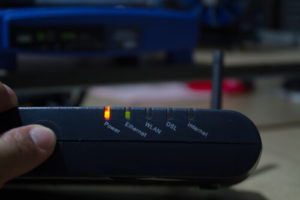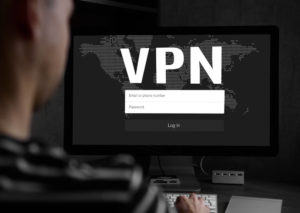
You probably already know there are a ton of cybersecurity risks you have to deal with whenever you decide to connect to a public Wi-Fi network.
That’s why need to be extremely cautious whenever you need to connect to one.
Follow our tips below to protect yourself when on a public Wi-Fi network to reap all of the rewards and none of the negative side effects of using a public Wi-Fi network.
Always Make Sure Your Device Is Set up Right
First and foremost, check the security settings of your device.
If you are using a Windows device, then you might want to set your profile to Public as the default connection profile.
Doing so will make sure that you never connect to an insecure and unknown network accidentally. (For more details on this subject, you can refer to this helpful tutorial.)
When it comes to online security and privacy, having the wrong security settings are pretty much as bad as having no security settings. Our suggestion is that you should go the route of manual configuration.
Always take extra care when you are trying to edit settings on your Windows machine. If you do not have the required confidence, then seek help from IT support.
Moreover, when you are connected to a public Wi-Fi network, do not download any kind of registry or editing files.
Taking such precautions will make sure you have sufficiently sharpened up your security settings.
The next simple step is to properly set up Private connections, which are usually known and secured. In a typical setting, such connections would include the Wi-Fi networks in your school, office, and home.
Our research shows that users should use Private settings for networks that they know are secured.
Check If You Have Activated Your Firewall
You should always have your firewall running healthily at all times.
And while you are at it, you should also make sure that you have your virus definitions completely up-to-date. In fact, put your antivirus product on auto-update so you can get the latest security updates and any security features as soon as they are rolled out.
Our readers would also know that the latest version of Windows is actually pretty good at things such as prompting users to take the time to set up their device’s firewall. So it is entirely possible that you might have already set up your firewall correctly.
As mentioned before, if you have not done so already, then make sure you turn on vital automatic updates for your virus definitions.
On the other hand, you can also change your habits a bit and keep updating yourself whenever you see that nagging update notification appearing on your screen.
If you’re a Mac user, you will also need to set up your firewall if you haven’t done so already. Macs (and Apple devices in general) are often wrongfully perceived to be immune from hackers, but recent research has shown that this is not the case.
Make sure you have turned on your firewall before you connect to any given public Wi-Fi network.
One good practice that we suggest all Mac users should adopt is to go to their System Preferences and then disable any and all Sharing options which you do not have any use of.
Software Updates Are Important. So Install Them.
Again, you will have to form another habit. Make it a point to install all available software updates on your computer as soon as you are prompted with their availability.
Software updates, for the most part, come with security patches.
If you stay up-to-date as far as your software updates are concerned, you give yourself the best chance of staying safe from all the known and new vulnerabilities that cybercriminals have a habit of exploiting to no end.
One other thing that you should note here is that modern hackers have the ability to trigger malicious and/or fake downloads on a given machine if it’s connected to a public Wi-Fi network without proper security.
It is because of this reason why we suggest to our readers that they should never make the mistake of downloading updates while connected to public Wi-Fi.
That is especially the case if you see a security alert popping up at the same time as you are using the public Wi-Fi network.
What you need to do in such a case is to first disconnect from the public Wi-Fi network and then check again for any updates when you are on a secured network.
VPN Services: Use Them.

Now, just because you may not use public Wi-Fi networks regularly does not mean that you don’t need any protection.
It is more than worth it to set up a good VPN service in order to protect all of your internet connections.
VPN services are great because they protect users by creating a dedicated and safe encrypted tunnel. Then they pass the user’s internet traffic through that tunnel. This ensures that the user’s activity stays completely hidden.
Moreover, the network that you have connected to will not have an impact on the security and privacy that a VPN service would grant you.
Here is another pro tip: You should never leave using a VPN service as the last step you take to secure yourself on the internet. In fact, if there is one thing you can do right now to protect yourself on the internet, that is to make use of a VPN service today.
We have lots of suggestions on which VPN service you should sign up for if you do not know that already.
Perhaps the overall point we want you to take away from all of this is that the next time you need to connect to a public Wi-Fi network—either for work or while traveling—then you should have a VPN set up and ready to go.
With that said, do keep in mind that many VPN services tend to slow down the speed of your internet connection. And this is no truer than on public Wi-Fi. We also know that VPN services differ a lot from each other in terms of speed.
Naturally, paid/premium VPN services are much faster than free products. They’re also more likely to have highly advanced security features for customers.
In other words, if you think that you rate performance as the most important feature of a given VPN service, then you should only sign up for top VPN service providers who offer high levels of performance.
Having a VPN subscription will definitely be worth it to protect your security.
When You Are Finished, Delete the Public Wi-Fi Network
This is also a very important step. If you have something that you want to protect on your computer or mobile device, then you need to remove the public Wi-Fi network that you connected to—regardless of the amount of time you spent connected to it.
Whether two minutes or two hours, you should remove the network from your computer’s Wi-Fi panel.
Make this a habit. Always delete any and all public Wi-Fi networks that you know you will only use once. Do that for all of your devices, not just your primary one.
If you use an Android device, if you go to your phone’s Wi-Fi settings, there is an option there labeled Forget Network. Tap it to remove the public Wi-Fi network. (Refer to Google’s support article on this topic here.)
If you use a Mac computer, then you only need to delete a given Wi-Fi network from your Wi-Fi network history. (See Apple’s support article on this topic here.)
Rest assured that if you make efforts to keep your Wi-Fi history pretty much as lean as possible, that will help you to avoid connecting to a malicious or fake Wi-Fi network at a later date.
Common Sense. Use It.
You will always come across situations where you need to connect to a public Wi-Fi network but do not have a VPN service installed on your phone.
If that is the case, then we suggest you should avoid connecting to websites that ask for your personal or sensitive information.
Examples of such sites include your banking website and any service that has your health records or social security number. Some would consider their Facebook profile to have sensitive information as well, so watch out for that.
Moreover, whenever you connect to a public Wi-Fi network, do not make the mistake of inputting your credit card number on any given site.
Do not access websites that do not have HTTPS (Hyper Text Transfer Protocol Secure). This protocol is implemented by websites to protect users’ security as data is sent from their browser to the website they’re trying to visit.
Many websites still do not use this protocol, so be on the lookout within your browser.
If there is an emergency, then you should disconnect your internet-enabled smartphone device from your public Wi-Fi connection and then use the tethering feature on your phone to start using 4G or 3G connection as is available.
Conclusion
That is pretty much all that you need to know about how to protect your Wi-Fi connection.
As you can see, most of what we have talked about is common sense.
We hope you have benefited from the tips and tricks we mentioned in this guide.
If you have more tips, let us know in the comments section below.
